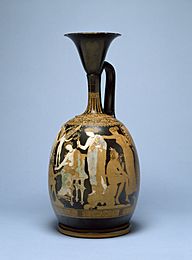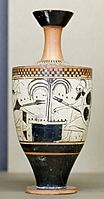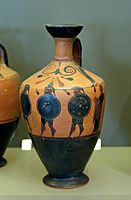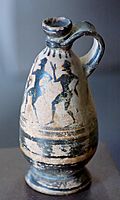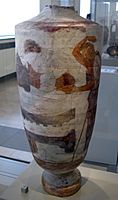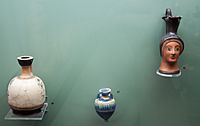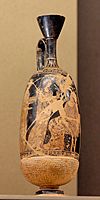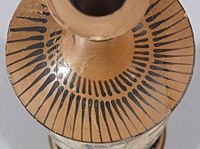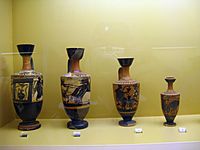Lekythos facts for kids
A lekythos (say "LEK-ih-thos") is a special type of ancient Greek pot. The word "lekythos" comes from the Greek word "λήκυθος". These pots were mainly used to store oil, especially olive oil.
Lekythoi have a narrow body and a single handle. This handle is attached to the neck of the pot. They look like a narrow jug but do not have a pouring lip.
Many lekythoi are made of pottery. However, some were also carved from stone. These pots were very important in ancient Greek life, especially for certain ceremonies.
Lekythoi were often used in ceremonies for the dead. They are also known for a special way of painting called the white ground technique. This painting style was too delicate for everyday items. Because of their handle, lekythoi usually have only one main picture. This picture is on the side opposite the handle.
What Lekythoi Were Used For
Lekythoi were often used in funerary rites, which are ceremonies for people who had died. They were especially used to prepare the bodies of unmarried women. Many lekythoi have been found in ancient tombs.
The pictures on lekythoi often showed scenes from daily life. They could also show rituals or ceremonies. Since they were used for burials, some pictures show funerary rites. These might include scenes of sadness or a feeling of leaving, like funerary art. The drawings are usually simple outlines. They often look serious and calm.
The pots were decorated with dull red and black paint. These colors might have come from the Bronze Age. However, they became popular in Athens around 530 BC. Some artists tried to add more colors, but they later stopped. This made the red and black stand out more. Lekythoi were very popular in the 5th century BC. But some have been found that date back to 700 BC.
These pots held perfumed oil. This oil was offered to the person who had died or to the gods of the underworld. Some lekythoi had a small inner chamber. This meant they needed less oil to fill them. Lekythoi were also used to put perfumed oil on a woman's skin before she got married. They were sometimes placed in the tombs of unmarried women. This was so they could prepare for a wedding in the afterlife.
Different Kinds of Lekythoi
Lekythoi come in several different shapes and sizes. Here are five main types:
- Standard or Cylindrical Lekythos: This is the most common type. It is usually between 30 and 50 centimeters (about 12 to 20 inches) tall. Some "huge lekythoi" could be as tall as 1 meter (about 3 feet). These very large ones might have been used instead of gravestones.
- Deianeria Lekythos: This type comes from Corinth. It has an oval shape and a round shoulder. These are usually small, about 20 centimeters (8 inches) tall. They were made from the early black-figure period until the late 6th century BC.
- Shoulder or Secondary Lekythos: This is a different version of the standard type. It was made starting in the mid-5th century BC. These pots have a fuller, more rounded body. Most are decorated with the white ground technique. They are usually around 20 centimeters (8 inches) tall.
- Squat Lekythos: These are usually less than 20 centimeters (8 inches) tall. They have a rounded belly and a flat bottom.
- Acorn Lekythos: This is a rarer type. It has an oval shape. At the bottom, it has a raised cup with bumps, like the cup of an acorn.
There are also "plastic" lekythoi. These pots have bodies shaped like a head, an animal, or another form.
Images for kids
-
Prothesis (lying in repose) (Attic plychrome lekythos (type V), from Alopeke, Group of the Huge Lekythoi, late 5th century BC)
See also
 In Spanish: Lécito para niños
In Spanish: Lécito para niños


